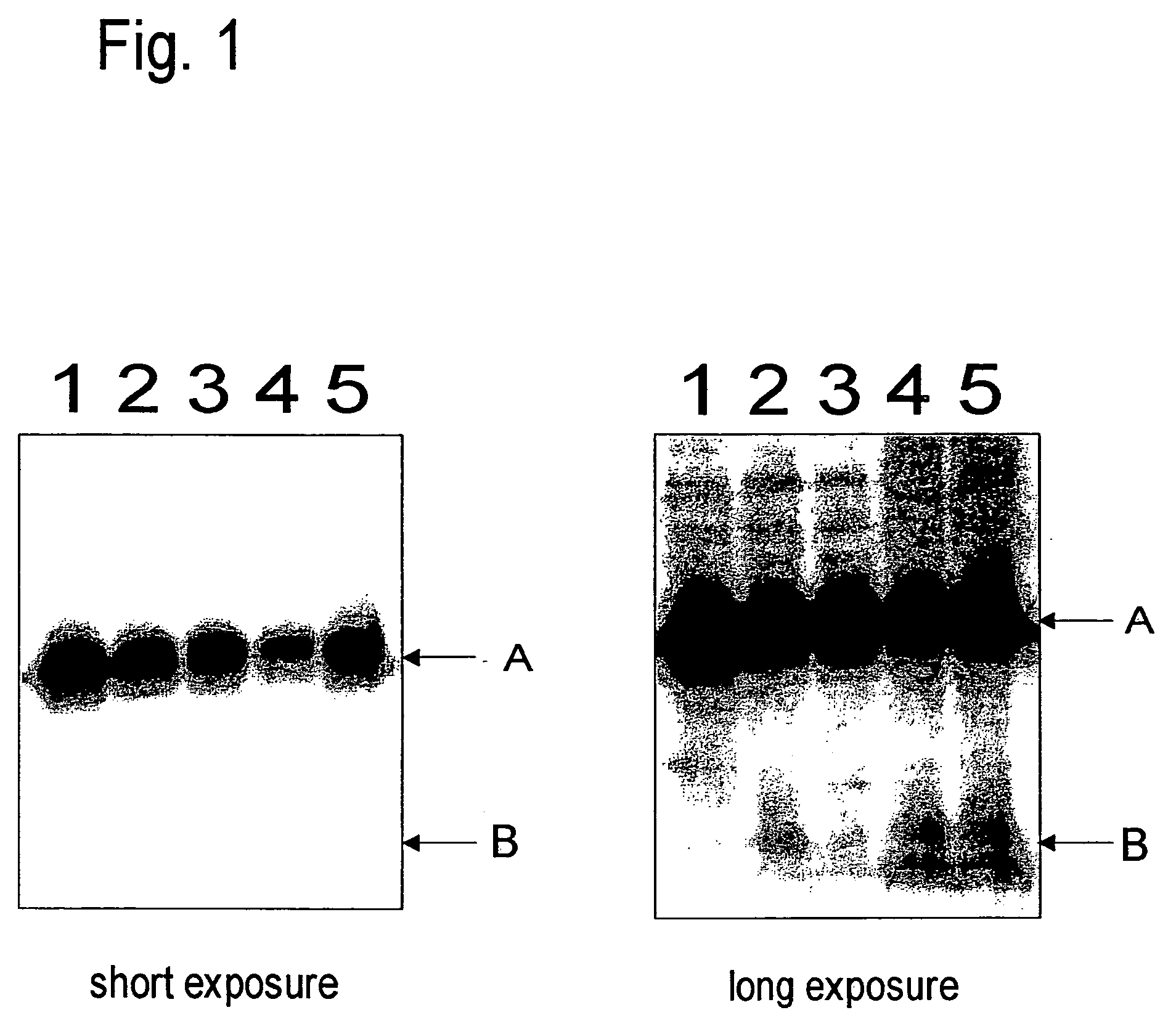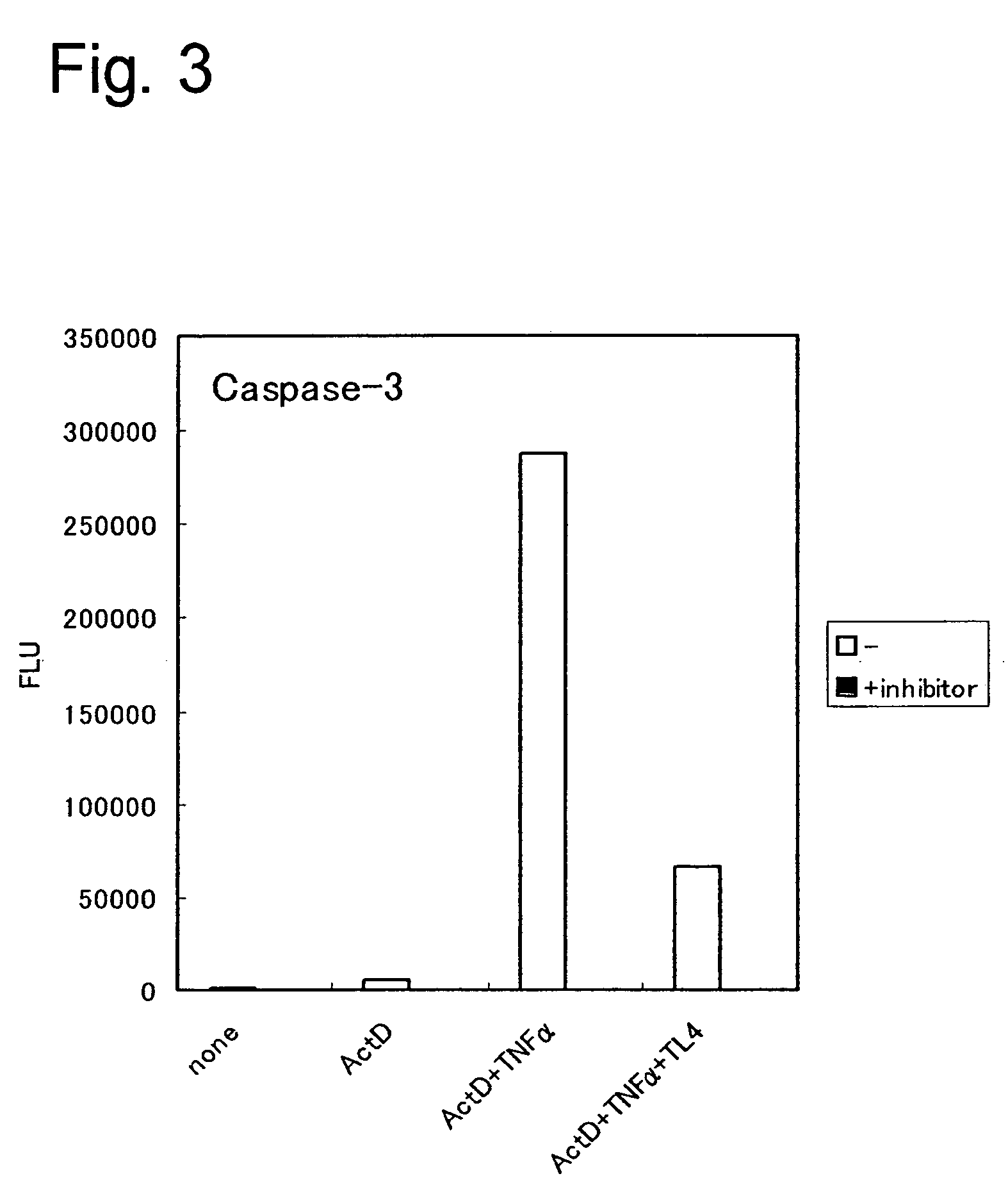Caspase 3 inhibitors
a technology of caspase 3 and inhibitors, applied in the field of new drugs, can solve the problems of insufficient investigation of therapies
- Summary
- Abstract
- Description
- Claims
- Application Information
AI Technical Summary
Benefits of technology
Problems solved by technology
Method used
Image
Examples
reference example 1
Cloning of cDNA Encoding Human-Derived TL4 Protein
[0473] The cloning of the cDNA was performed using GeneTrapper™ cDNA Positive Selection System (Gibco BRL).
[0474] The Escherichia coli DH12S strain of Superscript™ human liver cDNA library (Gibco BRL) was cultured in 100 μg / ml ampicillin-containing Terrific Broth [12 g / L Bacto-tryptone (Difco), 24 g / L Bacto-yeast extract (Difco), 2.3 g / L potassium monohydrogenphosphate, 12.5 g / L dipotassium hydrogenphosphate, 0.4% glycerol] at 30° C. for 16 hr. Then, cells were harvested and a plasmid cDNA library was prepared using Qiagen Plasmid Kit (Qiagen). The plasmid cDNA library was purified and digested with GeneII and ExoIII (both from Gibco BRL) to thereby prepare a single-stranded cDNA library.
[0475] On the other hand, a synthetic oligonucleotide (SEQ ID NO: 11) was used as a probe for screening the cDNA library. The probe was labeled by biotinylating its 3′ end with TdT and biotin-14-dCTT (Gibco BRL). The single-stranded cDNA library ...
reference example 2
Cloning of cDNA Encoding Mouse-Derived TL4 Protein
[0480] The cloning of the cDNA was performed by PCR. The Escherichia coli DH12S strain of Superscript™ mouse 8.5 day embryo-derived cDNA library (Gibco BRL) was cultured in 100 μg / ml ampicillin-containing Super Broth [32 g / L Bacto-tryptone (Difco), 20 g / L Bacto-yeast extract (Difco), 0.2 g / L NaCl] at 30° C. for 16 hr. Then, a plasmid cDNA library was prepared using Qiagen Plasmid Kit (Qiagen), and used as a template.
[0481] The following two synthetic oligonucleotides were used for primers:
5′-TCTGCTCTGGCATGGAGAGTGTGGT-3′;(SEQ ID NO:14)5′-CTATTGCTGGGTTTGAGGTGAGTC-3′.(SEQ ID NO:15)
[0482] A PCR reaction was performed in a system containing TaKaRa Ex Taq (Takara Shuzo) using a thermal cycler (GeneAmpR PCR System 2400; PerkinElmer) under the following conditions: 1 cycle of 94° C., 20 sec; 30 cycles of 94° C., 20 sec / 55° C., 30 sec / 72° C., 2 min; and leaving at 4° C.
[0483] The resultant amplified fragment was inserted into pT7Blue T-...
reference example 3
Cloning of a Chromosomal Gene Comprising the Coding Region of the Mouse-Derived TL4 Protein Gene
[0503] A chromosomal DNA fragment encoding a region comprising the open reading frame of the mouse-derived TL4 protein was isolated by plaque hybridization using Lambda FIXυ II library (Stratagene) in which fragments of 129SVJ mouse chromosomal DNA partially digested with Sau3AI had been incorporated and, as a probe, a labeled mouse-derived TL4 protein cDNA. First, to the phage solution diluted to give a concentration of 1−10×104 pfu (plaque-forming unit) / ml, an equal volume of culture broth of E. coli XL1-Blue MRA cultured in LB medium supplemented with 0.2% maltose and 10 mM MgSO4 overnight at 30° C. was added and mixed. Then, this mixture was incubated at 37° C. for 10 min. To 200 μl of this mixture, 5 ml of top agarose (NZY medium [5 g / L NaCl, 2 g / L MgSO4.7H2O, 5 g / L yeast extract, 10 g / L NZ amine (adjusted to pH 7.5)] to which agarose was added to give a concentration of 0.7%) pre-...
PUM
 Login to View More
Login to View More Abstract
Description
Claims
Application Information
 Login to View More
Login to View More - R&D
- Intellectual Property
- Life Sciences
- Materials
- Tech Scout
- Unparalleled Data Quality
- Higher Quality Content
- 60% Fewer Hallucinations
Browse by: Latest US Patents, China's latest patents, Technical Efficacy Thesaurus, Application Domain, Technology Topic, Popular Technical Reports.
© 2025 PatSnap. All rights reserved.Legal|Privacy policy|Modern Slavery Act Transparency Statement|Sitemap|About US| Contact US: help@patsnap.com



